Agelenopsis, American grass spiders, are a genus of spiders that can be found around the world and in every US state. They are some of the fastest spiders in the United States and can be fun just to watch if you can trigger the web right.
Using a long piece of a weed or grass, try tickling the web as a bug would, if it was struggling across the web. If you do it right, the Grass Spider will run out with lightning speed, looking for a meal.
Then again, if you don’t mind seeing it, you can always throw a bug in its web.
Quick Overview: Agelenopsis – American Grass Spider
Medically significant: No
Body size: 3/4 inch (19 mm)
Main colors: brown, black
Range: Throughout the United States
Web: Funnel-shaped web
Agelenopsis Description
The abdomen is oblong, with long spinnerets at the end. Most species of the American Grass Spider have a pattern of stripes running from front to back. On the abdomen, there are often two white stripes, which are broken into many sections. The Cephalothorax on the other hand, has the lighter stripe running down the middle, dividing two dark stripes.
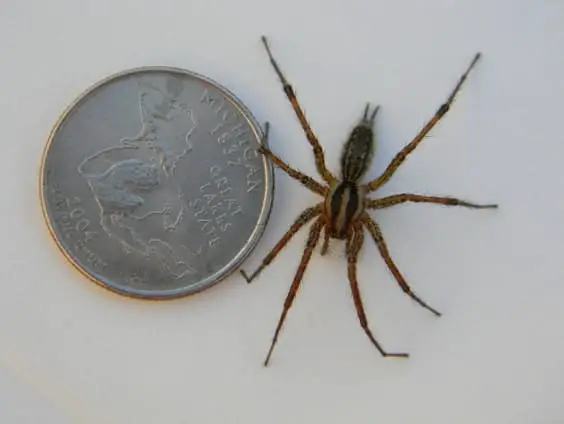
The grass spider is often confused with some similar looking species of the wolf spider or the American Nursery web spider. In the Pacific Northwest, the grass spider’s distribution overlaps with the related hobo spider (Eratigena agrestis) and the giant house spider (Eratigena atrica). Both of these spiders are also part of the funnel-weaver family (Agelenidae) and have a similar appearance to the grass spider. The best way to distingiush the grass spider from these species are the clear three lighter lines that run along the cephalothorax (head) of the grass spider. Hobo spiders and giant house spiders don’t have these longitudinal lines but other, less-distinctive markings.
Eyes
Grass spiders have eight eyes. The eight eyes are all similar-sized and form an oval shape. You can see a closeup photo of the grass spider eyes below:
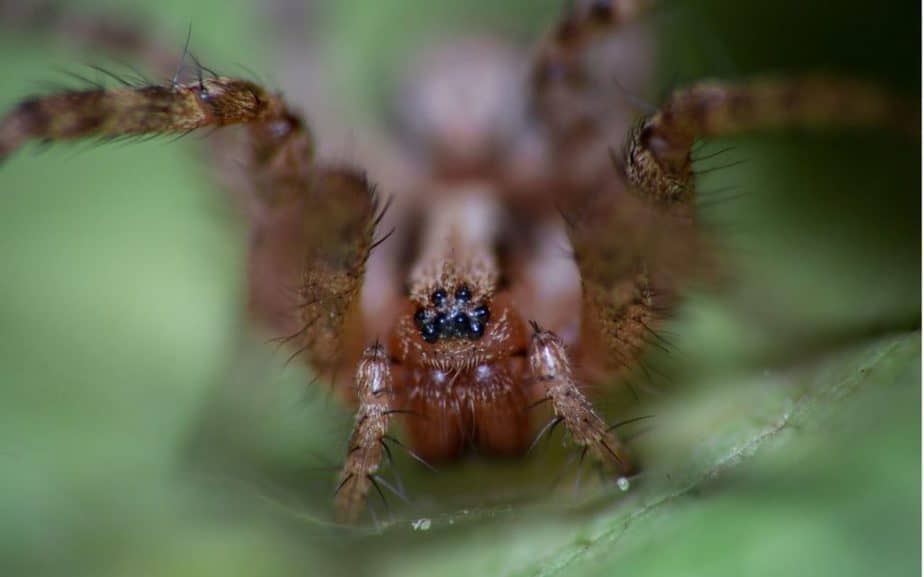
Size
The bodies will grow to 3/4” (19 mm) from front to back, and approximately 1 ½” (38 mm) including the legs.
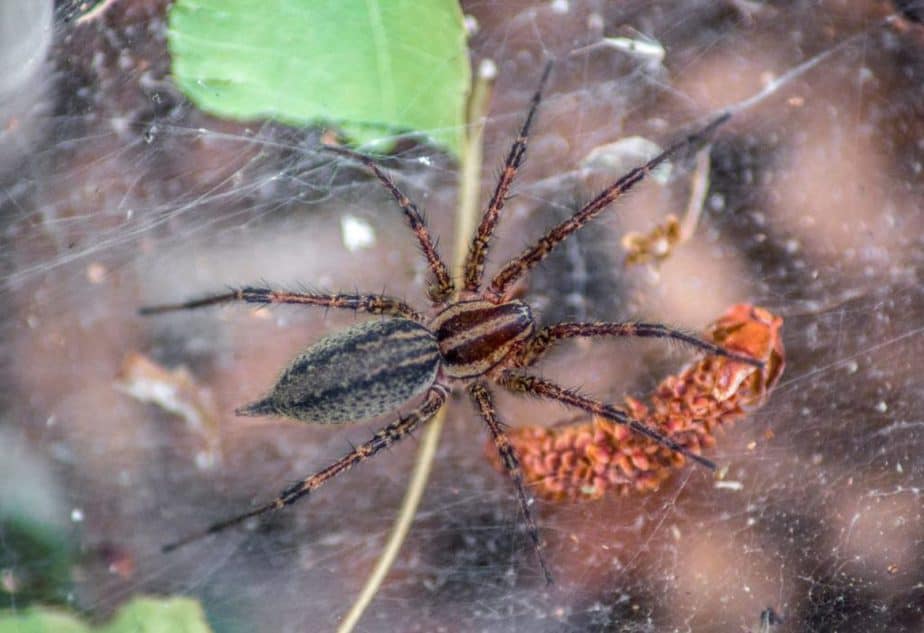
Web
They always spin their webs horizontally, creating a thick floor, which will feed into a funnel at one end. The spider hides in the funnel section, waiting for its next meal to crawl upon its web. However, the webs are not the sticky kind, which are used to trap prey. Instead, they trigger vibrations on the web, which the spider feels. The Grass Spider then uses its speed to charge and attack its prey.
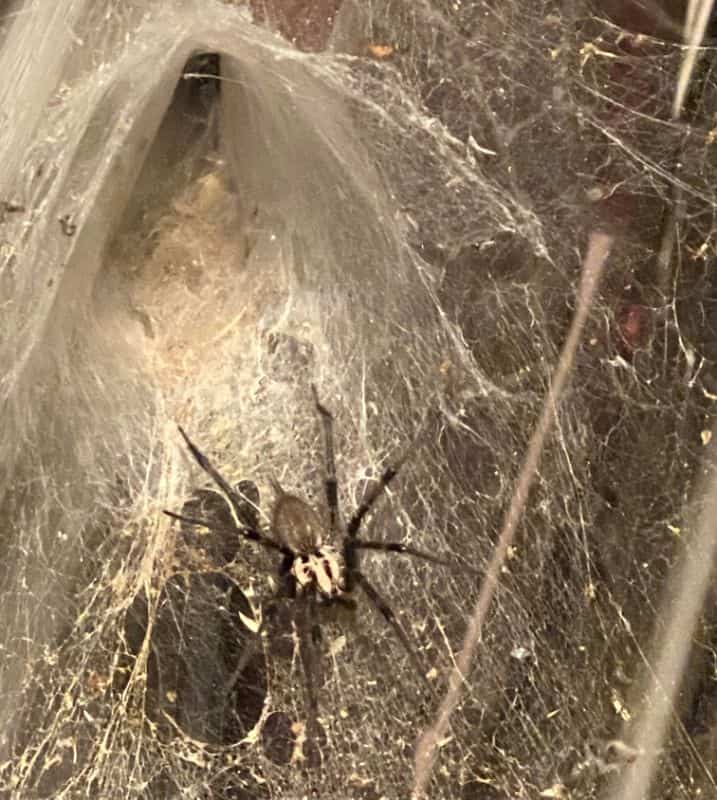
Grass spider bites
The Grass Spider is considered quite harmless to humans. They stay in their webs and do not venture out unless forced to do so. A bite can cause some local swelling, redness and itchiness but is not dangerous.
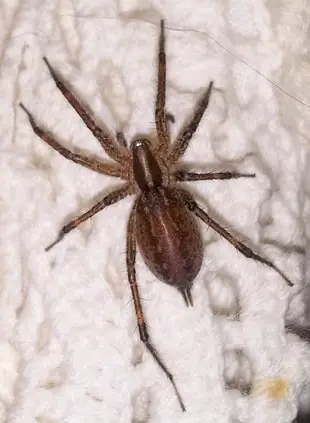
Agelenopsis Scientific Classification
- Kingdom: Animalia
- Phylum: Arthropoda
- Subphylum: Chelicerata
- Class: Arachnida
- Order: Araneae
- Infraorder: Araneomorphae
- Family: Agelenidae
- Genus: Agelenopsis
Other common names
The Grass Spider is also known as the American funnel-web spider or funnel weaver. It is not to be confused with the Funnel Web Spider, which is a very dangerous spider in Australia. To limit confusion, we strictly stick to the name American grass spider or grass spider.
Distribution of the American grass spider in the USA
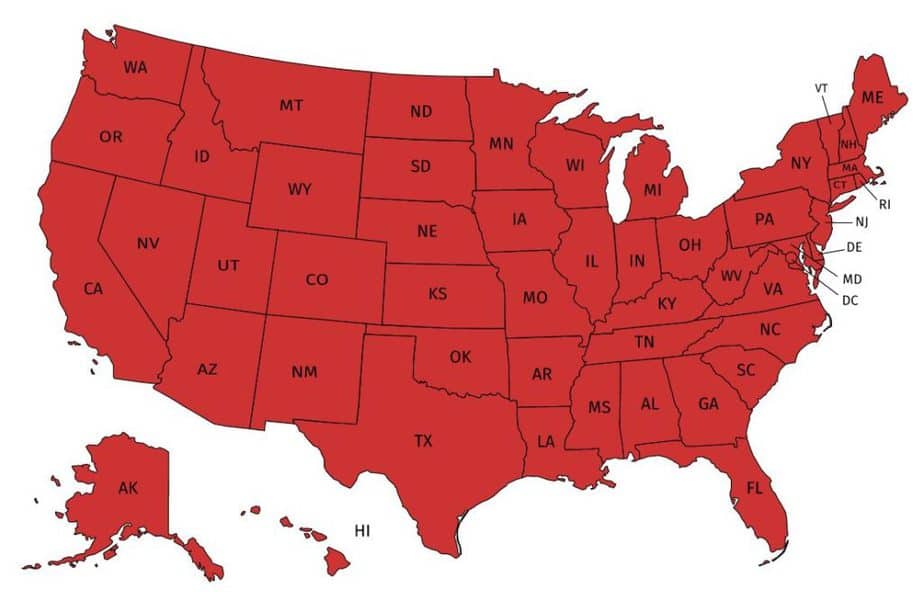
Various species of the American grass spider can be found throughout the United States – Alabama, Alaska, Arizona, Arkansas, California, Colorado, Connecticut, Delaware, Florida, Georgia, Hawaii, Idaho, Illinois, Indiana, Iowa, Kansas, Kentucky, Louisiana, Maine, Maryland, Massachusetts, Michigan, Minnesota, Mississippi, Missouri, Montana, Nebraska, Nevada, New Hampshire, New Jersey, New Mexico, New York, North Carolina, North Dakota, Ohio, Oklahoma, Oregon, Pennsylvania, Rhode Island, South Carolina, South Dakota, Tennessee, Texas, Utah, Vermont, Virginia, Washington, West Virginia, Wisconsin, Wyoming
Grass spider photos
Here are some more photos of grass spiders that have been submitted by our readers:
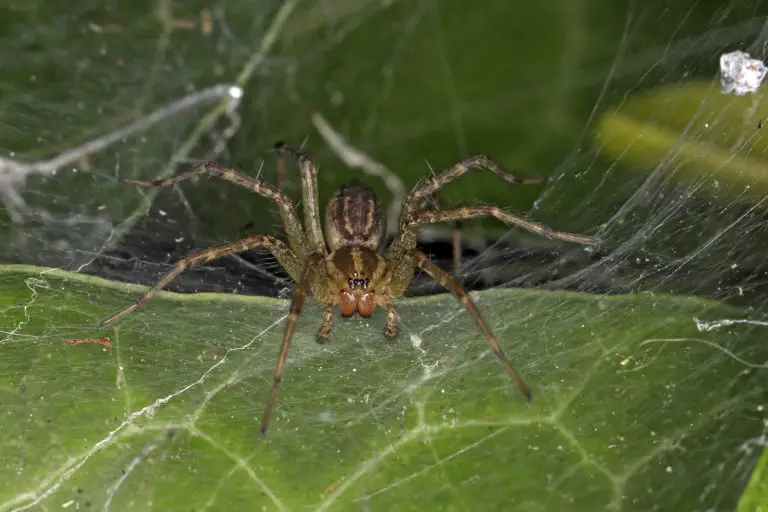
A great closeup shot showing the eye pattern of a grass spider (Agelenopsis) . Found in New Jersey by Rich. 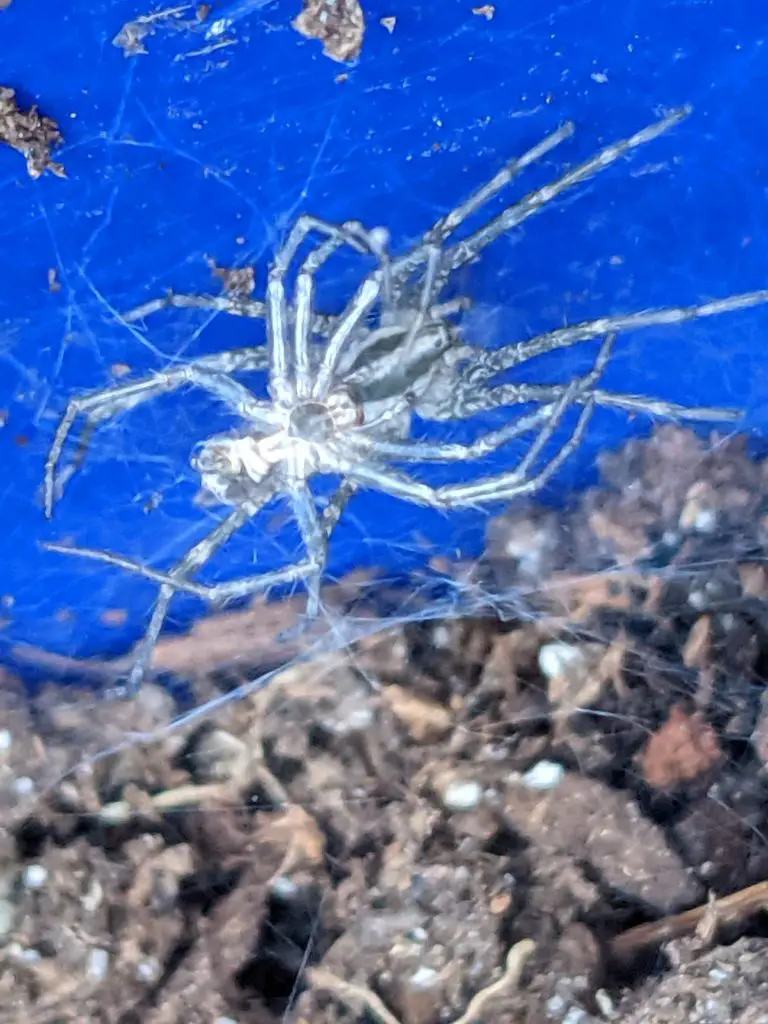
Exosceleton of a grass spider- Submitted by Jaye Bird 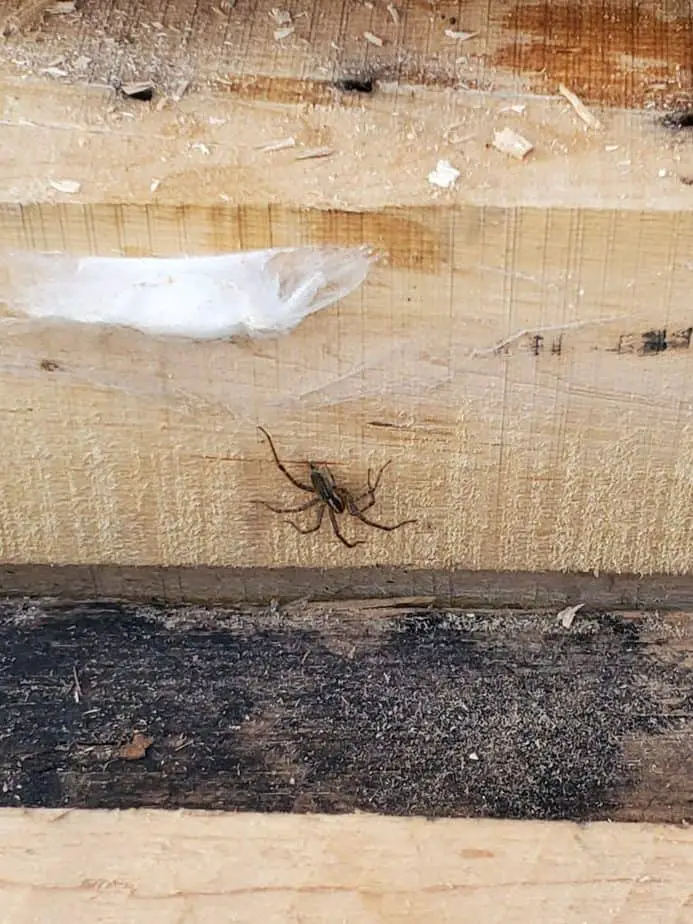
An American grass spider found by Kalie. 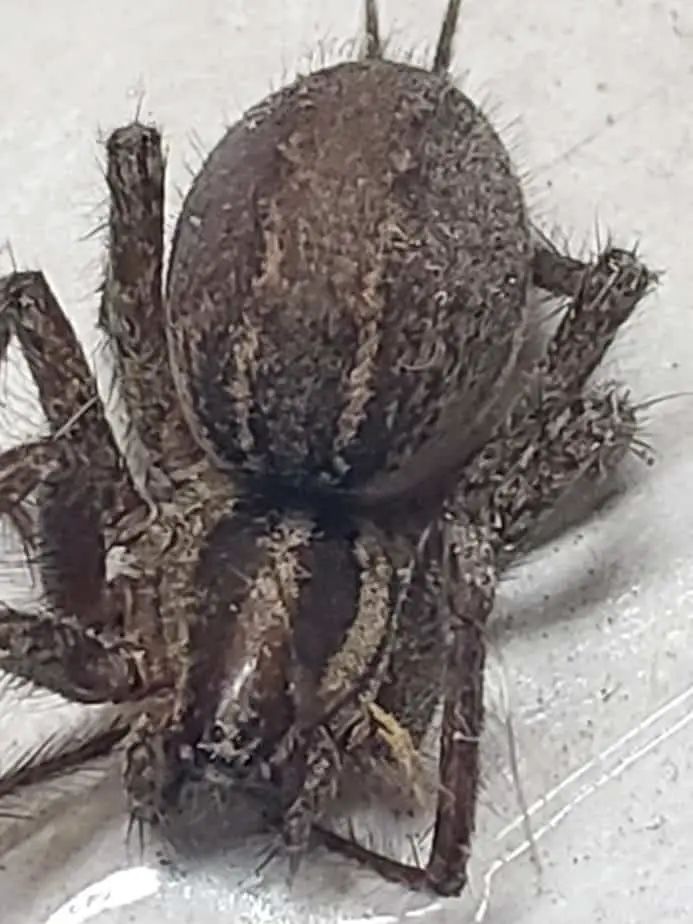
A gravid grass spider found by Teresa in Sioux Falls, South Dakota 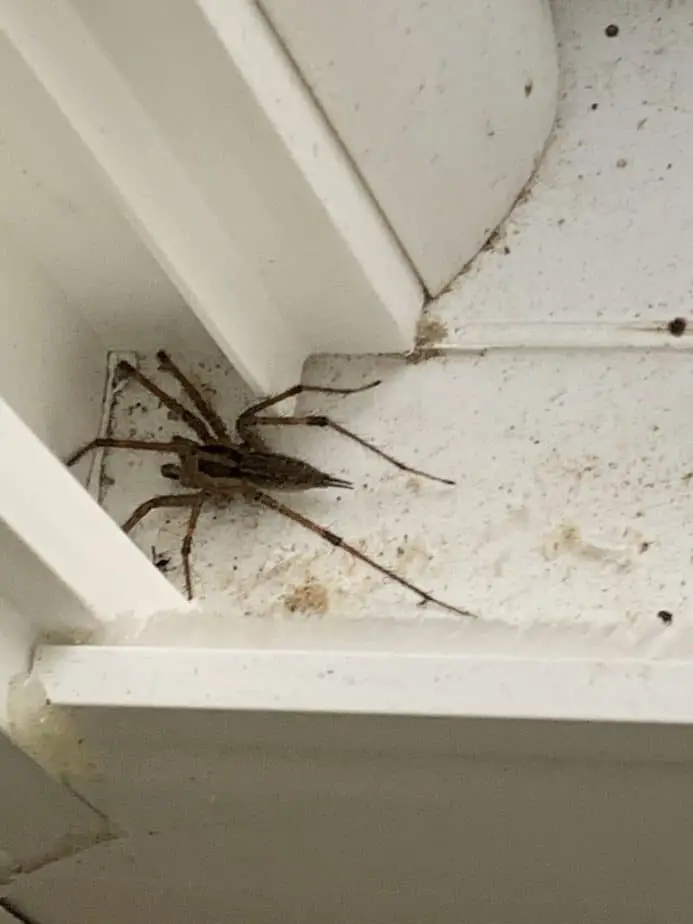
A slender grass spider with long spinnerets. Found by Jess. 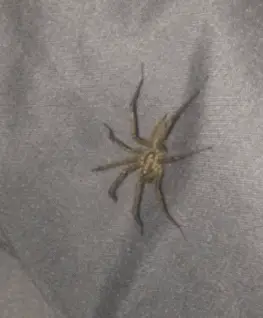
Grass spiders are often confused with similar-looking wolf spiders. This grass spider was found by Lisa in Withee, Wisconsin. 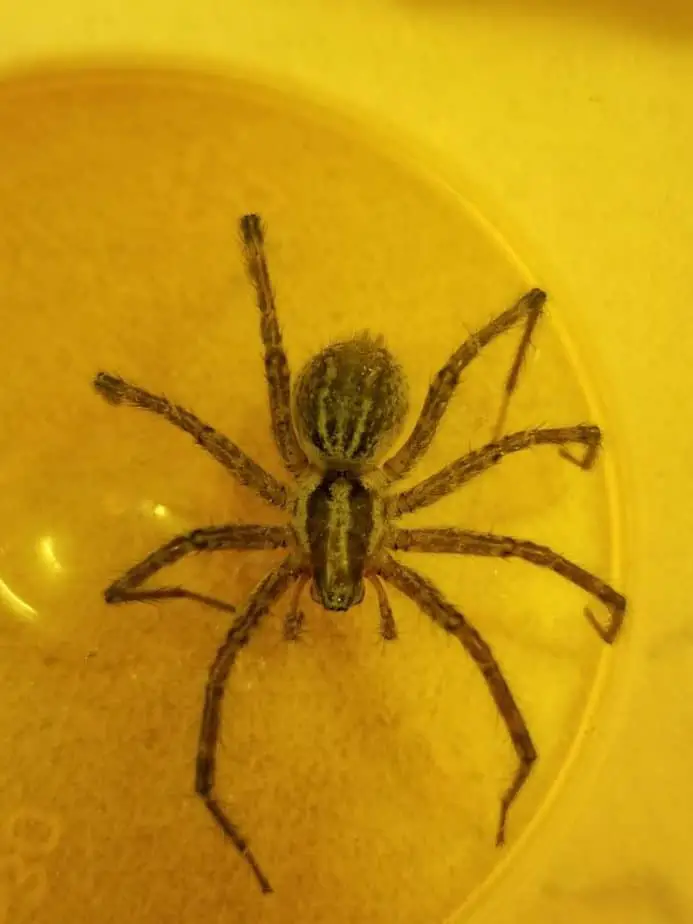
Agelenopsis spider found by Gabriel in October 2020.

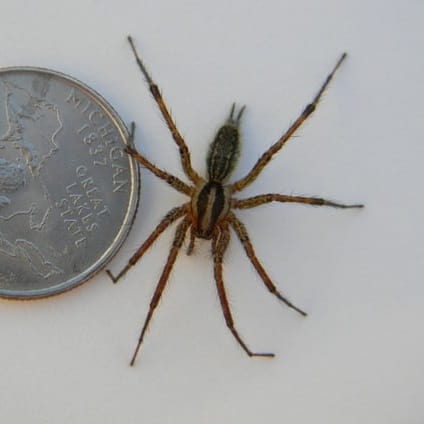
Hey I found of the grass land spiders and I just want to know if they make good pets
Hey Jerry, thanks for getting in touch! Yes, you can absolutely keep a grass spider as a pet. Grass spiders are funnel weavers and create funnel-shaped webs. Make sure to add some twigs and leaves in one area/corner of the enclosure where it can set up its web.
Here is some more information:
https://www.wikihow.com/Keep-Grass-Spiders
This was found in my house (south/east) Michigan. I couldn’t squish so I put a glass over it. Was still alive 3/4 days later (no webs inside of inverted glass) Released into yard, after looking into and thinking it was best. Any feedback? Did I screw up?
Is this a grass spider?
Hey, would you say this is the same spider as above? They tend to find their way into the house and I have small several small pets.
Is this a grass spider? Found in northern MN. I have a lot of these in my house. The orange-ish oval on its back is making me question it. It’s approx: 1/2 inch
Hello Reef, thanks for getting in touch. This is a wolf spider, not a grass spider. You can read more information about them here: https://usaspiders.com/lycosidae-wolf-spider/
They are also harmless.
Hello,
Can you help me identify this spider that I found in my bathroom? It looks so similar to an American Grass spider but also a Rabid Wolf spider. It’s being quarantined under a glass dish until I can find out if it’s poisonous. Thanks!
Found this spider just inside my back door? I didn’t see any photos on your site that look like this.
Hi John, thanks for the photo. This is some type of funnel-web spider of the family Agelenopsis. It could be Agelenopsis naevia but it’s hard to make an ID off the picture alone. It would help if you could mention the location where you found the spider.
Regardless of the exact genus or species, Agelenopsis spiders are not medically significant. You can read our overview of the similar and closely related American grass spider here: https://usaspiders.com/agelenopsis-american-grass-spider/
I’ve seen a few of these around my house in Indiana. Not quite sure what it is.
Hello Kaymen, this is a wolf spider (Lycosidae), not a grass spider: https://usaspiders.com/lycosidae-wolf-spider/
O-0 big ol’ quarter sized spider found in northern utah, no web. Primarily brown and gray(?)
Hello Nessa, this is some type of funnel-web spider of the spider family Agelenidae. They are not medically significant. It might be a grass spider or a close relative. Here is more information about it: https://usaspiders.com/agelenopsis-american-grass-spider/
Hi! Nashville Indiana here…
This medium sized guy came to visit me in my garden tonight. Your thoughts on who he is is greatly appreciated!
Hi Theresa, thanks for getting in touch! This is a wolf spider, not a grass spider. Wolf spiders are also not medically significant: https://usaspiders.com/lycosidae-wolf-spider/
Hi, I found a spider who looked exactly like the one used as the main example for American grass spiders before clicking the the “more” link in my kitchen sink tonight. It was definitely NOT the size of a quarter – more like a half dollar, and probably a bit larger, still. As I had no idea what it was and my three year old was at my side, my only concern was making sure I secured my home but it didn’t seem to be bothered by the pot of water potted on it and it couldn’t scale the sink basin to get out. Could it have been a harmless grass spider? Do they get that big?
Hello Denise, yes, grass spiders can get that big. It might have also been a giant house spider (Eratigena atrica) – they look somewhat similar: https://usaspiders.com/eratigena-atrica-giant-house-spider/
It depends on your location. None of the large brown spiders that look similar to grass spiders in the U.S. are medically significant. The only medically significant brown spider is the brown recluse which is not that big and looks different.
What is this spider and is it a concern since I have 2 small dogs and a child?
Hello Mike, thanks for getting in touch! This spider is not medically significant for humans or dogs. It’s a grass spider: https://usaspiders.com/agelenopsis-american-grass-spider/
Found this in a pair of shoes I just purchased. Any idea what it is? Dangerous?
Hello Steven, thanks for getting in touch. This is an American grass spider (Agelenopsis sp.). It’s not a medically significant spider: https://usaspiders.com/agelenopsis-american-grass-spider/
Hello can you tell me what this is? Thanks
Hello Tyler, thanks for getting in touch. This is a grass spider (Agelenopsis sp.).
I live in New Jersey, and I saw these two spiders this evening by the garage. I’ve never seen this kind of web before. I took another photo from the side to show you what their bodies look like. What kind of spiders are they?
Hello Barbara, it’s hard to ID them just off their webs – they could be some type of cobweb spiders or even orb weavers with the web on the left belonging to a different species. Can you upload the picture of the spider itself to the reply here? That will help with the identification.
Hellllpp! I hate spiders and this is the second one I’ve found I my apartment in the last week!
Found this spider by my door in Shenandoah county Virginia, overall it was larger than a quarter.
Hello Kirk, thanks for getting in touch! This is a gravid female funnel web spider – most likely a grass spider (Agelenopsis sp.). It’s not a medically significant spider. They spin funnel-shaped webs in corners and catch smaller insects: https://usaspiders.com/agelenopsis-american-grass-spider/
Found this guy out back of a hair salon recently. Think it’s a male wolf spider but I’m not sure
Found this spider at the back of my house in Brighton MI
Hadn’t seen a spider like this before
Hi Rick, thanks for getting in touch. This is a grass spider (Agelenopsis sp.): https://usaspiders.com/agelenopsis-american-grass-spider/
This spider has been in a corner of my garage (Michigan) for a while and has built a pretty impressive web that it likes to stay in. I think it’s a grass spider?
Hello Charlie, thanks for sharing this great shot! I agree that this is most likely a grass spider. There is a small possibility that it is a giant house spider (Eratigena atrica) which has also established populations in Michigan: https://usaspiders.com/eratigena-atrica-giant-house-spider/
Here’s a quick little bugger we found setting up shop above our yard faucet in Missoula Montana.
Do you guys think these are the same spiders? Found in Southeastern WI.
Spider 1: found on garage, no web located.
Spider 2: found by patio door, funnel web located nearby.
Both grass spiders?
Hello Lauren, thanks for getting in touch! Yes, these are both grass spiders.
PLEASE Tell me what type of spider this is please?!
Found inside house on wall in living room in Orr, Minnesota. Hairy legs. Size of a quarter. Who is this guy? Please help. Thank you!
Hello Adam, thanks for getting in touch! This is a grass spider (Agelenopsis sp.): https://usaspiders.com/agelenopsis-american-grass-spider/
Found this in Baltimore Maryland. It was on my closet door, threw a Gatorade bottle at it and it ran so fast it almost got away if it wasn’t so big.
Hello Vaughn, thanks for getting in touch! This is a male grass spider (Agelenopsis sp.): https://usaspiders.com/agelenopsis-american-grass-spider/
It’s not a medically significant spider – maybe next time you can let it get away unharmed 😉
Found this hairy dude in Northern New Hampshire. I am hoping you’re able to identify it. I’ve been looking but and not sure what it is. I appreciate your assistance and thank you for your time answering everyone’s questions.
Thank you!
Hello there, thanks for getting in touch! This is a male fierce orbweaver (Araneus saevus). Despite its name, this spider is not aggressive or dangerous. It can be safely relocated.
Found in NY
Hello Erin, thanks for getting in touch! This is a grass spider (Agelenopsis sp.): https://usaspiders.com/agelenidae/grass-spider/
It’s not medically significant.
My sister has this spider in her sink. I would guess that it is about an inch in length.
Hello John, thanks for getting in touch! This is a grass spider (Agelenopsis sp.). It’s not medically significant. You can read more about them here: https://usaspiders.com/agelenidae/grass-spider/
Just found this guy in my basement bedroom…
Found thimy home, home,Long Island New York. It ran very fast.
Hello April, thanks for getting in touch! This is a male funnel weaving spider of the family Agelenidae. Most likely a grass spider (Agelenopsis sp.): https://usaspiders.com/agelenopsis-american-grass-spider/
It’s not a medically significant spider.
This is the second spider i have recently found in my house. First on was in my kitchen this one was by my pillows i just happened to notice as i was laying down for bed.
Hello Jeremiah, thanks for getting in touch! This is a grass spider (Agelenopsis sp.): https://usaspiders.com/agelenopsis-american-grass-spider/
It’s not a medically significant spider.
My daughter found this fellow. I can’t decide if he’s a grass spider or giant house spider. Now free, but his size gave her quite a scare.
Hello Greyson, where did you find this spider? The location is always helpful for identification.
not sure what kind of spider this is, i found it in a funnel shaped web in my car its been there three days and its about the size of a dime and it is shy but i put a bug in the web and it was very quick. can you help?
Ugh! I found this VERY LARGE dead spider floating at the bottom of my horse trough. This pic is through a foot of water. I scooped it out with a fish net, but even tough it was dead, I was still too scared to put my hand next to it for a size comparison. I was about the size of a half dollar. Largest spider I’ve ever seen. I’m in Granite Falls, WA. Pretty sure it’s a Grass Spider.
Hello Laura, thanks for getting in touch! This is a close relative of the grass spider, a giant house spider (Eratigena atrica/duellica): https://usaspiders.com/eratigena-atrica-giant-house-spider/
It’s not a medically significant spider.
Hello, we have this friendly spider living in our kitchen and we feed him crickets from time to time. Assuming he is an agelenopsis, what is their expected life span in an indoor environment where cold weather is not a concern? We have named him “Mr. Brain” 😆
Hello Tim, yes, Mr Brain is a grass spider. Their lifespan is usually around one year – they will usually die with the first frost after laying eggs. If you keep the spider inside during the colder time of the year, there is a small chance that it might survive a few months extra. But it will be unlikely that it will live through spring.
PLEASE Tell me what type of spider this is please?!
I have hundreds of these little guys in my garden, but only in my garden, no where else. Their body is only about 1/8 inch long. Are they grass spiders and why do they like my garden so much?
Hello Darla, thanks for getting in touch! This is a wolf spider. You are probably seeing many as they might have emerged from one or a few egg sacs in your garden. They are not medically significant.
Any idea what kind of spider this is? Looks kind of like a grass spider, but the body is wider. Maybe pregnant? It was bigger than a quarter.
Found inside my entryway right as I opened the door. Big & scary looking. I don’t think it’s a drain spider.
Hello Heather, thanks for getting in touch! This is a type of a funnel-weaving spider, most likely an American grass spider (Agelenopsis sp.): https://usaspiders.com/agelenopsis-american-grass-spider/
They are not medically significant spiders.
Can you tell what kind of spider this is. Found on door in Benson, NC
Hi Mark, thanks for getting in touch! This is a grass spider (Agelenopsis sp.): https://usaspiders.com/agelenopsis-american-grass-spider/
Found 8n Duluth, Minnesota
Hello Rusty, thanks for getting in touch! This is a grass spider (Agelenopsis sp.): https://usaspiders.com/agelenopsis-american-grass-spider/
It’s not a medically significant spider.
Spider in my bathroom. I live in eastern South Dakota.
Hello Emily, this is a grass spider (Agelenopsis sp.): https://usaspiders.com/agelenopsis-american-grass-spider/
It’s not medically significant. This one is female and looks gravid.
We found this guy living in our bathroom sink in Sterling, VA. It’s building a somewhat disorganized web (as far as I can tell) on the surface of the basin and around the drain. It moves quickly around the basin. Any ideas?
Hello Laura, this is an American grass spider (Agelenopsis sp.): https://usaspiders.com/agelenopsis-american-grass-spider/
Was on the outside on our porch near the house. Camden, TN
Hello Monica, this is an American grass spider (Agelenopsis sp.): https://usaspiders.com/agelenopsis-american-grass-spider/
Once I’d been scraped off the ceiling, your site helped me identify this as a grass spider and prevented me from grabbing my dog, my purse, selling the house, and moving to a hotel permanently. It was found on one of my little dog’s sweaters just as I was about to put it on her. I’d taken it from a pile of sweaters in a darkish corner of my living room where I’d left them since last winter. I’m sending a picture because I thought it would be a helpful one for identification.
Hello Pamela, thanks for getting in touch! I’m glad you didn’t have to move out of your house 🙂 This is a great shot of an American grass spider – thanks for sharing it!
Is this a grass spider? It was really big.
For starters, thank you so much for what you are doing here. It’s great to be informed on whether or not some of these spiders could be a threat to humans or pets and the information you have is so wonderful. I am not a fan of anything that crawls but I do try to keep an open mind with spiders as long as they won’t harm me or my family.
On that note I’m curious about this big guy/gal I found in my garage. Everything I’m reading is pointing towards grass spider but being in mid-southern Indiana and the coloring/pattern I’m wondering if maybe it could be a wolf spider. Any help would be appreciated!
Hello Christina, thanks for the kind words!
This is definitely a grass spider, not a wolf spider. The body shape and color patterns can look very similar for the two spider families. But the long spinnerets at the back of the abdomen are a sure giveaway that this is a spider in the family Agelenidae (grass spider).
In Philadelphia. Size of thumb, maybe.
Hello Angel, thanks for getting in touch! This is an American grass spider (Agelenopsis sp.): https://usaspiders.com/agelenopsis-american-grass-spider/
Found in my backyard in San Francisco, CA. There are a bunch of them crawling through the grasses and bushes. Some are bigger and more elongated than others.
Hi Jo, this looks more like a wolf spider rather than a grass spider.
found this one this morning. it blends in so well…. is this a grass spider? just a shade bigger than a big half dollar.
Hi micb, this is most likely not a grass spider. I would say this is a fishing spider (Dolomedes sp.): https://usaspiders.com/dolomedes-fishing-spider/
This spider was quite large, body alone at least 2 inches. There are many spiders around this apartment complex which is bordered by woods in northern WV but I’ve never seen one that looked like this or this BIG.
I’m terrified to leave my apartment. I think it feasts on small children.
Can anyone help identify what kind of spider(s) these are? I think they’re all the same kind. We had two of these living under the upper trim in our carport last summer, and one again this year. Now they’ve relocated to our basket of kindling and the space between a couple boards someone nailed together. The webs tend to be messy sheets (‘cobwebs’), but also have tunnels that go into whatever smaller hidey space is nearby (the one living between the boards made its web outside the boards, with a tunnel going down into the space between them).
Hi Mitch, these are all funnel web spiders of the family Agelenidae. They are not medically significant. Most likely, they are all grass spiders (genus Agelenopsis): https://usaspiders.com/agelenopsis-american-grass-spider/
Your location would help determine the genus/species with higher confidence.
Found in Sumner, Illinois. There’s an invasion in my lawn and rock garden outside of my back door. They’re about dime size, legs and all. Fast and jumpy!
Hi Kimberly, this is a grass spider (Agelenopsis): https://usaspiders.com/agelenopsis-american-grass-spider/
Hello- this little friend is in the window of my Airbnb. I’d be sure it was a grass spider except for the bright red dot. I saw a fly easily escape the horizontal web the other day so I’m going to say the web isn’t very sticky. The spider likes to hide in the crack in the window crank when it isn’t lounging on the web.
Hi Anne, this is a grass spider (Agelenopsis): https://usaspiders.com/agelenopsis-american-grass-spider/
The red spot can either be some organic debris stuck on the spider or – more likely – a parasitic red mite on the spider.
Found what I believe was one of these in my basement in my house in NJ. Actually my cats found it and were meowing because they couldn’t reach it. Not knowing what the spider was and because I wasn’t sure if it would bite the cats as they tend to put bugs in their mouth, I squashed it. Much to the displeasure of the cats.
Found this in central Florida right near the grass in the morning. I had thought it was a grass spider but was told it could be a thin legged wolf spider. It was very small (smaller than a thumbnail) so it was hard to really get a good look. Thanks
Hi Lacy, this is a male grass spider (Agelenopsis sp.): https://usaspiders.com/agelenopsis-american-grass-spider/
This was found in my backyard in Southeast Michigan, I have never seen one of these before. Any ideas?
I believe this is a grass spider. Found it at Allaire state park in NJ
Thought I’d share a piece of trash I was going to pick up. I believe it is a dew-bejeweled grass spider web, located in Orleans County, NY. It’s hard to see but the spider is in the bottom of the funnel.
I feel like this is a grass spider but would like a second opinion. Is there any reason I should kill it? It lives in a hole in the baseboard behind my toilet. It looked smaller yesterday so I’m thinking there’s more than one living there. Thanks in advance
Legs could span a us quarter with ease. Found In Wisconsin. Grass spider or perhaps giant house spider?
Hi Mks, this is a grass spider (Agelenopsis sp.): https://usaspiders.com/agelenopsis-american-grass-spider/
I hope that uploaded. After looking at all the pictures, I am very sure that it is a grass spider that came into the house due to the cold nights. Actually we have had about 5 of them. They have all the correct markings, the body is dark colored and thy have long spinerettes. Everything fits except that only 1 of them ran quickly. The others stopped, stayed very still and actually seemed to look at us – is that possible? We never hurt them – we cover them with a bottle and transport them outside on a pice of thin cardboard. Could they communicate with each other? I studied Biology in college, so though I don’t like them running around my house, I do appreciate them. I think I did lay my arm on one on my dark leather couch arm because I had a swollen, itch area, but you can’t blame them!
Found this guy in a tangled web between my basement bathroom sink and wall. Semi aggressive if my hand got too close. This was just a few days ago during September in northern Ohio. Thanks!
Hi Ketih, this is a grass spider (Agelenopsis sp.): https://usaspiders.com/agelenopsis-american-grass-spider/
Found this lil guy in the basement…
Hi there, this is a grass spider (Agelenopsis sp.): https://usaspiders.com/agelenopsis-american-grass-spider/
Found this on my dock just outside of my boat. I’m located in Frenchman’s Bay Marina just east of Toronto Ontario. Grass spider or Wolf spider. Everything I’ve just read so far, says nothing about Canada.
Thank you.
Ya not exaggerating but this guy was buried in mulch I was diggin out in Florida! He was as round as a soda can! He was the only spider in a ten foot area of much so I am assuming he ate the rest!
Just your friendly neighborhood grass spider enjoying some snacks. This one just molted also! I thought there were 2 spiders at first, then I realized.
I realized I sent you a photo of the bottom of my spider. This is the top. Body about .5″ Colorado Springs, CO. Found indoors in basement
I am debating between Thin-legged Wolf Spider and American Grass Spider on this one.
Your spider-identifier questionnaire suggests this is a grass spider. While its funnel web has graced my marigolds most of the summer, I’ve only seen the spider this once, and only its back end. Can you confirm? Many thanks!
Hello I get these in my house everytime the season is changing. What is this?